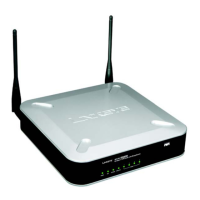41
Chapter 6: Configuring the Wireless-G VPN Router
The VPN Tab - IPSec VPN
Wireless-G VPN Router with RangeBooster
Figure 6-37: Local Secure Group - Subnet
and Remote Secure Group - IP Addr.
Figure 6-36: The VPN Tab - IPSec VPN
The VPN Tab - IPSec VPN
The VPN Router creates a tunnel or secure channel between two endpoints, so that the transmitted data or
information between these endpoints is secure.
Tunnel Entry. To establish this tunnel, select the tunnel you wish to create from the drop-down box. It is possible
to create up to 5 gateway-to-gateway tunnels.
VPN Tunnel. Click Enabled to enable the selected VPN Tunnel.
Tunnel Name. Once the tunnel is enabled, enter the name of the tunnel. This allows you to identify multiple
tunnels and does not have to match the name used at the other end of the tunnel.
NAT-Traversal. You can select this option to enable NAT-Traversal to make IPSec tunnels with remote peers. NAT-
Traversal is developed for the IPSec peer behind the NAT device to avoid error identification of IKE phase and ESP
packet fallacious authentication which are caused by NAT IP translation. It will help to establish IPSec tunnels and
encapsulate the ESP packet into UDP packet. While the IP address and port number of such UDP packet being
modified by NAT, the encapsulated ESP can still be integrity for remote IPSec peer verification. Because we do not
know where the NAT server of the remote peer is located exactly, the Remote Secure Group and Remote Secure
Gateway must be set to Any when NAT-Traversal is enabled.
Select Enabled to enable NAT-Traversal support for this tunnel, and Disabled to disable it.
Local Secure Group
The Local Secure Group is the computer(s) on your LAN that can access the tunnel. From the drop-down menu,
select Subnet, to include the entire network for the tunnel; select IP Address if you want a specific computer; IP
Range, if you want to include a range of IP addresses; or select Host, which is used with Port Forwarding to
direct the traffic to the correct computer. The screen will change depending on the selected option. The options
are described below.
Subnet. Enter the IP Address and Mask of the local VPN Router in the fields provided. To allow access to the
entire IP subnet, enter 0 for the last set of IP Addresses. (e.g. 192.168.1.0).
IP Addr. Enter the IP Address of the local VPN Router. The Mask will be displayed.
Host. The VPN tunnel will terminate at the router with this setting. Use Port Range Forwarding to direct traffic to
the correct computer. Refer to the Port Range Forwarding tab of the Firewall tab.

